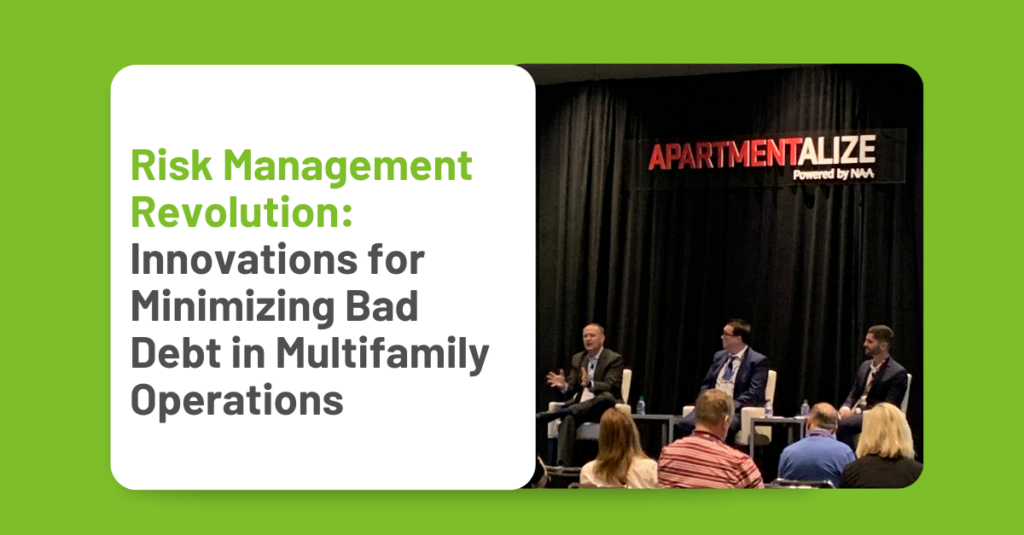With changing market dynamics and the looming threat of an inflation-induced recession, it is crucial to reassess our perception of property performance. In the realm of revenue management, we have come to understand the utmost significance of real-time data. Multifamily operations demand constant attention and cannot be treated as a static “set it and forget it” industry. Moreover, a cookie-cutter approach is ineffective as every property has its unique needs.
In a recent panel discussion that took place at NAA’s Apartmentalize Conference, operators discussed insights and strategies they’ve implemented to mitigate risks, manage bad debt, and enhance net operating income. Participants included Johnny De La Espriella, Sr. Vice President at RKW Residential, Kevin Hott, Vice President of Information and Technology Systems at E&S Ring, Kevin Huss, Vice President of Enterprise Sales at LeaseLock, and Jeremy Thomason – Executive Vice President of Asset Management and Investor Relations at CAF Companies.

Don’t just collect data – analyze it!
Having data is just one piece of the pie. Engaging with data is another. Kevin Hott explained the significance of regular check-ins on Mondays to discuss the prior week’s traffic, trends, trouble areas, and challenges. A weekly game plan is developed and adjusted based on those learnings to tackle challenges in real time. As an added layer, he takes the reports of information and develops a tool that allows visibility from a high level of color-coded problems and opportunities.
Jeremy Thompson shared how bad debt has become a major focus more recently, after years of poor debt management. He illustrates that the volume of debt on the table is like a pot of gold – you want the pot of gold to be small, but you still want to be able to collect it. When analyzing details such as post-moratoriums on evictions, was there something that could have been caught? Or is fraud detection leaving a hole?
Upticks in fraud demanding risk management solutions
Panelists shared that 85% of apartment managers now report application fraud, spanning an average of 1 out of 8 applications, highlighting the need for fraud prevention as a critical solution. Furthermore, eviction costs total as high as $7,000/unit compiling to millions in medium to larger sized portfolios. By investing in screening services, bad debt can be prevented before it turns into bad debt.
There is a stark contrast between legislation in California and Texas for landlord support, Jeremy added. The traditional model of a security deposit has evolved, therefore putting solutions on the front end can take out some of the risk game, especially in locations where landlords have less control. When you can isolate risk, you can remove it. Renters insurance undoubtedly, is the best way to minimize risk as well as services that lookout for lapses in rental insurance. Another option suggested by Johnny De La Espriella is to include vendors who can offer flexible rent payment programs to help struggling renters pay their full balances over a split time frame rather than all at once so they don’t fall behind.
Additionally, tools such as credit reports, and amenities that aid in promoting on-time rent payments for credit building can be a successful tool to help implement for mitigating risk and promoting positive financial hygiene across your communities.
Centralization hype in the realm of risk management
Centralization is without a doubt one of the hottest buzz words in multifamily. All hype aside, panelists shared implementation strategies that have been working for them to help manage debt. Analyzing whether or not it makes sense to bring collections in house is one example of streamlining processes. Some leasing agents despise having to collect late payments. Others don’t mind. Being able to centralize this type of an operation to a specific specialized roles not only saves costs and boosts employee moral, but creates room for greater job satisfaction to the personalities who don’t want to face the confrontation of late rent payments. Remove the discomfort from these agent’s to-do lists, and now you have a retention value added.
Ensuring you have the best technology to do the taxing work is a major component operators are looking deeper into. We’ve had a spike in recent years for tech innovation across the industry, but now it’s time to see what can work for you. Quantify savings that platforms are giving back, leverage the latest technology including AI bots that can not only assist your residents and deliver a more efficient experience, but can help identify the gaps with data to uncover what’s working, and where you have leaks.
As the multifamily industry adapts to shifting market dynamics, it’s clear that embracing technology and data-driven solutions is crucial for effective risk management. Panelists emphasized the need to analyze and engage with data, enabling operators to identify trends, address challenges, and seize opportunities in real-time. Finding the right technology, forming the best conventional or centralized mix of processes for various communities, and embracing AI will empower operators to navigate market uncertainties with confidence and drive sustainable success.

